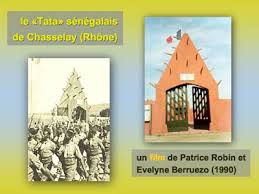The Senegalese Tata
A film by Eveline Berruezo and Patrice Robin
The battle of France (10th May - 25th June 1940)
3 september 1939 Britain and France declare war on Germany
10 may 1940 Germany invades France
13 may 1940 German tanks break through at Sedan
27 may-4 june 1940 Evacuation of British and (some) French troops at Dunkirk
10 june 1940 Italy enters the war, on the side of Germany
18 june 1940 From London, General de Gaulle calls on the French to continue resistance
19-20 june 1940 Fighting at Montluzin, Chasselay (north-west of Lyons)
22 june 1940 Signature of the Franco-German armistice at Rethondes
25 june 1940 The cease-fire comes into effect
This film tells the compelling story of a Tata. A Tata is an African cemetery. This one is unique in that it is in the middle of the French countryside, in the Beaujolais country north-west of Lyons. It is the burial place of Senegalese infantrymen who fought for France in 1940.
Who were the Senegalese infantrymen (1857-1962) ?
The Senegalese infantrymen (Tirailleurs sénégalais) were colonial infantry units in the French Army recruited from 17 sub-Saharan countries : Benin, Burkina Faso, Cameroon, The Central African Republic, The Comoros, The Republic of the Congo, Ivory Coast, Djibouti, Gabon, Guinea, Madagascar, Mali, Mauritania, Niger, Senegal, Chad and Togo).
From their creation by Louis Faidherbe in 1857 until their disbandment at the beginning of the 1960s, they were initially deployed in French colonial campaigns. This African force, whose fighting qualities were recognised by World War I general Charles Mangin, would play an important role in both World Wars.
June 1940 : Senegalese infantrymen ("tirailleurs") fight against the Nazis.
June 1940 saw France's army defeated, after six week's fighting, by Hitler's Panzer divisions. At the end of this disastrous campaign, for two long and bloody days, Senegalese infantrymen defended a key military position on the roads to Lyons, the Chasselay-Montluzin zone, against the Nazi enemy. The battle at Chasselay was instrument al in allowing the French to negociate an unoccupied zone in southern France. But in victory, the Germans showed no mercy to troops whom they regarded as subhuman because of their race.
al in allowing the French to negociate an unoccupied zone in southern France. But in victory, the Germans showed no mercy to troops whom they regarded as subhuman because of their race.
The dead lie in the Tata, inaugurated in 1942. Like all military cemeteries and commemorative monuments, the Tata will offer a reference point for future generations. But the Tata is no ordinary war memorial. It commemorates not only men who died in battle, but men who were murdered in cold blood after their surrender. It commemorates men forgotten in the main narrative of France's defeat.
To watch the film :
Bearing witness
In Berruezo and Robin's film, the first serious investigation of the Tata in any form, witnesses remember the horror of that battle, and speak out, breaking a decades-old taboo.
- [...] You must remember that in Senegal there were 4 "communes" : Dakar, Rufisque, Gorée and Saint Louis. There were considered French - at the time they called it the "statut général".
- What about the others ?
- People born in any of the other departments were considered "natives". So they were viewed as Africans, and anyone born in one of the four I've just mentioned were full-blown French.
- You were French, then?
- I was French.
- And now you live in France. What's that like ?
[...]
- And in Thiaroye ?
- [...] There was ingratitude. The tirailleurs who took part in all the wars France was involved in, some even participating in the Liberation - who fought for years and years - they weren't paid. Some were repatriated when the war was over. [...] When they reached Thiaroye, it was : there's no money left. No money left. And some were massacred. [...] There's a song written by the late Kieta Fodeba, a poet, "Minuit" ("Mindnight"). It is a very sad song about the tirailleurs and also about the massacre at Thiaroye
One of the witnesses appearing in the film Le Tata, Paysages de pierres
News
Partnerships
OIF - Organisation internationale de la Francophonie

Dans le cadre de la Coopération Franco-Vietnamienne > Revue des actions menées > "Le Tata - Paysage de pierres" de Patrice Robin et Evelyne Berruezo
L’Institut français

www.ifcinema.institutfrancais.com/fr/movie?id=f9bcf3ef-3775-96b1-e112-dff98822852c

